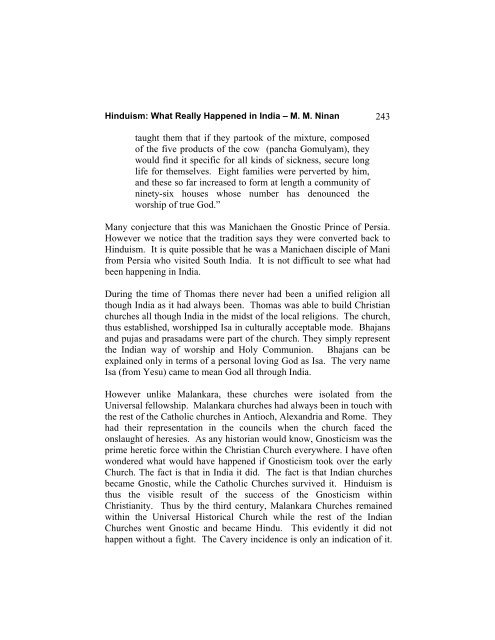Hinduism: What Really Happenned in India (PDF) - Oration
Hinduism: What Really Happenned in India (PDF) - Oration
Hinduism: What Really Happenned in India (PDF) - Oration
You also want an ePaper? Increase the reach of your titles
YUMPU automatically turns print PDFs into web optimized ePapers that Google loves.
<strong>H<strong>in</strong>duism</strong>: <strong>What</strong> <strong>Really</strong> Happened <strong>in</strong> <strong>India</strong> – M. M. N<strong>in</strong>an<br />
taught them that if they partook of the mixture, composed<br />
of the five products of the cow (pancha Gomulyam), they<br />
would f<strong>in</strong>d it specific for all k<strong>in</strong>ds of sickness, secure long<br />
life for themselves. Eight families were perverted by him,<br />
and these so far <strong>in</strong>creased to form at length a community of<br />
n<strong>in</strong>ety-six houses whose number has denounced the<br />
worship of true God.”<br />
243<br />
Many conjecture that this was Manichaen the Gnostic Pr<strong>in</strong>ce of Persia.<br />
However we notice that the tradition says they were converted back to<br />
<strong>H<strong>in</strong>duism</strong>. It is quite possible that he was a Manichaen disciple of Mani<br />
from Persia who visited South <strong>India</strong>. It is not difficult to see what had<br />
been happen<strong>in</strong>g <strong>in</strong> <strong>India</strong>.<br />
Dur<strong>in</strong>g the time of Thomas there never had been a unified religion all<br />
though <strong>India</strong> as it had always been. Thomas was able to build Christian<br />
churches all though <strong>India</strong> <strong>in</strong> the midst of the local religions. The church,<br />
thus established, worshipped Isa <strong>in</strong> culturally acceptable mode. Bhajans<br />
and pujas and prasadams were part of the church. They simply represent<br />
the <strong>India</strong>n way of worship and Holy Communion. Bhajans can be<br />
expla<strong>in</strong>ed only <strong>in</strong> terms of a personal lov<strong>in</strong>g God as Isa. The very name<br />
Isa (from Yesu) came to mean God all through <strong>India</strong>.<br />
However unlike Malankara, these churches were isolated from the<br />
Universal fellowship. Malankara churches had always been <strong>in</strong> touch with<br />
the rest of the Catholic churches <strong>in</strong> Antioch, Alexandria and Rome. They<br />
had their representation <strong>in</strong> the councils when the church faced the<br />
onslaught of heresies. As any historian would know, Gnosticism was the<br />
prime heretic force with<strong>in</strong> the Christian Church everywhere. I have often<br />
wondered what would have happened if Gnosticism took over the early<br />
Church. The fact is that <strong>in</strong> <strong>India</strong> it did. The fact is that <strong>India</strong>n churches<br />
became Gnostic, while the Catholic Churches survived it. <strong>H<strong>in</strong>duism</strong> is<br />
thus the visible result of the success of the Gnosticism with<strong>in</strong><br />
Christianity. Thus by the third century, Malankara Churches rema<strong>in</strong>ed<br />
with<strong>in</strong> the Universal Historical Church while the rest of the <strong>India</strong>n<br />
Churches went Gnostic and became H<strong>in</strong>du. This evidently it did not<br />
happen without a fight. The Cavery <strong>in</strong>cidence is only an <strong>in</strong>dication of it.



